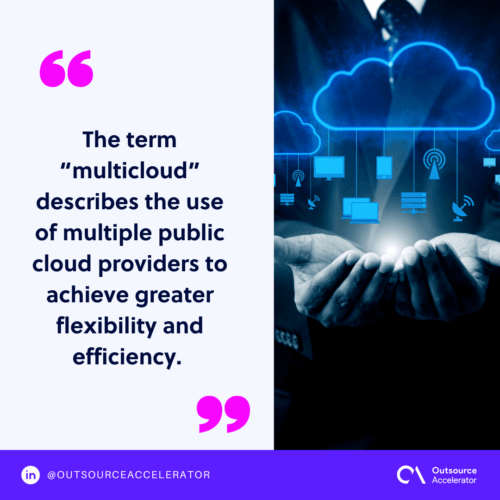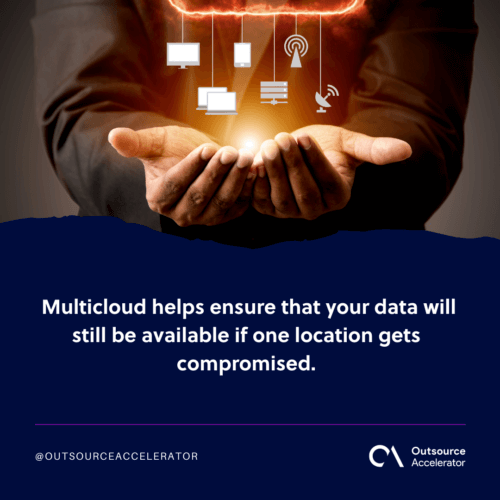Discovering the potential of a multicloud strategy

The multicloud strategy is revolutionizing the way organizations leverage cloud computing.
By breaking free from the constraints of a single cloud provider, businesses can unlock a world of possibilities. They can harness the power of diverse cloud environments to drive efficiency, innovation, and, ultimately, business success.
Defining multicloud
The term “multicloud” describes the use of multiple public cloud providers to achieve greater flexibility and efficiency. Multicloud combines them into one seamless environment that lets you run your workload across any combination of clouds.
This allows you to take advantage of the best features of each public cloud vendor while reducing your dependency on any single provider. You can choose the best solution for each workload based on cost, resiliency, and functionality.
What is multicloud management?
Multicloud management is the ability to manage multiple clouds from a single platform. The platform should enable you to provide a unified view of all your cloud resources and set up policies for your applications.
By leveraging multicloud management, you can:
- Choose the right cloud for each workload
- Optimize performance and cost for each use case
- Maximize application compatibility across multiple providers
- Migrate applications between clouds easily

Multicloud vs. Hybrid cloud
A multicloud platform is frequently mistaken for a hybrid cloud platform. The two differ most in their architecture, but there are a few other notable differences:
| Multicloud | Hybrid cloud |
| Comprises two or more public cloud services | Has a combination of public and private cloud services |
| Designed for high availability | Designed to require some degree of management from the owner |
| Offers almost infinite storage space, backups, and disaster recovery capabilities | Offers a more finite resource for data storage, with uptime and disaster recovery concerns |
| Difficult to implement unified security | More possible to implement unified security |
| Allows for cloud-to-cloud data transfer | Allows for data transfer between the hybrid clouds |
10 common applications of multicloud in businesses
Here are the most common multicloud use cases:
1. Disaster recovery
Most businesses are growing increasingly dependent on cloud services. This makes it more important than ever to have a disaster recovery plan in place in case their primary data center goes down.
A multicloud strategy offers many benefits for disaster recovery. It gives users better control over their infrastructure and data, allowing them to scale up or down as needed without investing in extra equipment.
2. Vendor lock-in mitigation
In many cases, cloud providers offer their own proprietary software and services for managing infrastructure. This can make it difficult for customers to move workloads from one provider to another.
Multicloud management tools can handle applications across multiple clouds without vendor lock-in. With these tools, you can also choose which cloud providers to use based on price and performance.
This use case is particularly true for enterprises with large-scale deployments that may have already invested in more than one cloud platform.
3. Geographic redundancy
When a business operates in multiple locations around the world, it can be difficult to maintain a consistent level of service in each location.
A multicloud environment solves that problem. You’ll be able to provide local data access without having to worry about availability if there are problems at one location.
Geographic redundancy is often used in combination with other scenarios, such as disaster recovery. It provides an additional level of security over traditional single-region deployments.
4. Application portability
Application portability refers to the ability to move applications between different cloud providers without rewriting code or losing functionality.
In the multicloud platform, organizations can balance performance and cost while ensuring their applications are always available.
This is particularly useful for applications that are still under development or testing when there’s no need to migrate everything to production quite yet. It also makes sense if you want to test how well your application performs on different providers.
5. Cost optimization
Companies are increasingly looking to cut costs while maintaining agility and flexibility. With a multicloud strategy, they can achieve both by leveraging the best-in-breed cloud providers in each category — whether that’s infrastructure, platform, or software.
The ability to scale up or down on demand can help companies avoid paying for capacity during off-peak hours. This is especially beneficial for companies that have predictable workloads.
6. Hybrid cloud integration
Hybrid cloud integration is a popular use case for multicloud computing. It’s a strategy that allows businesses to utilize multiple clouds based on their needs, such as a public cloud for computing and storage, and a private cloud for data centers.
This hybrid approach also helps organizations mitigate risk by keeping sensitive data within their own infrastructure while leveraging the public cloud’s cost benefits.
7. Compliance and security
When you have sensitive data that needs to be protected from unauthorized access, you’ll often need to deploy an environment that stores your data in multiple locations at once. Multicloud helps ensure that your data will still be available if one location gets compromised.
Multi-cloud deployment also makes compliance easier. It allows organizations to adhere more closely to industry regulations without worrying about whether their infrastructure meets those requirements.

8. Load balancing and performance optimization
Cloud-native applications are distributed by nature. They often require additional load balancing and other performance-enhancing features that come as traffic engineering tools.
With load balancing, you can distribute traffic across the multicloud to spread requests evenly across your instances. This ensures the service is always available and responds quickly to user requests.
With performance optimization, you can use multiple instances to serve user traffic while maintaining high performance. This helps ensure that users don’t experience any latency when accessing your application.
9. DevOps and testing
The DevOps process aims to promote communication and collaboration between developers, operations, and other IT personnel working on projects.
In a multicloud environment, the DevOps process entails managing multiple cloud resources, such as:
- Public cloud services
- Private cloud environments
- Hybrid clouds
Testing also falls under the umbrella of DevOps. When testing your application in a multicloud environment, you must ensure that it works across all platforms because your users may be accessing your site from anywhere in the world.
If your app fails on one platform but works fine on another, then you need to ensure it doesn’t fail on all platforms.
10. Data backup and archiving
Multicloud use cases are often associated with data backup and archiving. This is because these processes require the user to keep a copy of the data in multiple locations so that they still have access to their data if there is an issue with one of them.
Why use a multicloud strategy?
A multicloud strategy is one of the most effective ways to manage your IT infrastructure. It allows you to:
- Reduce costs – Using a multicloud strategy enables you to reduce capital costs by shifting from on-premises hardware to cloud services. You can also reduce operational costs using a single set of tools and processes for multiple clouds.
- Increase agility – A multicloud strategy lets you quickly provision resources in any location, so you can respond flexibly to business needs.
- Optimize performance – When you use multiple clouds, you can optimize resource allocation and performance based on your application workloads and availability requirements.







 Independent
Independent




